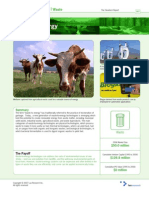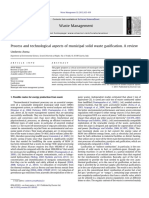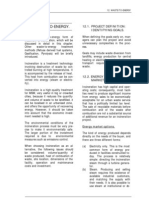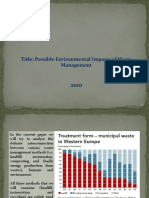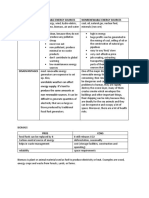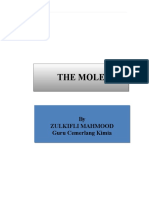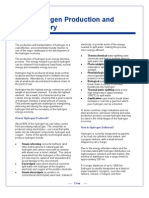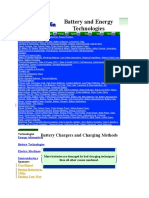Conversion of MSW Transfer Stations Into Renewable Energy Centers
Conversion of MSW Transfer Stations Into Renewable Energy Centers
Uploaded by
Jaime RamirezCopyright:
Available Formats
Conversion of MSW Transfer Stations Into Renewable Energy Centers
Conversion of MSW Transfer Stations Into Renewable Energy Centers
Uploaded by
Jaime RamirezOriginal Description:
Original Title
Copyright
Available Formats
Share this document
Did you find this document useful?
Is this content inappropriate?
Copyright:
Available Formats
Conversion of MSW Transfer Stations Into Renewable Energy Centers
Conversion of MSW Transfer Stations Into Renewable Energy Centers
Uploaded by
Jaime RamirezCopyright:
Available Formats
Conversion of MSW Transfer Stations into
Renewable Energy Centers
Municipal Solid Waste Transfer Stations (MSWTS) play an important Wastes Common to MSWTS
role in a community’s total waste management system, serving as the Waste Category Generated by Contains
link between a community’s solid waste collection program and a final
Municipal solid households, businesses, food containers, packaging, food
waste disposal facility. W2E has developed an innovative system of
waste (MSW) institutions, and industry wastes, and paper products
converting municipal solid waste (MSW) into a slate of usable energy
and energy-related products. Yard waste biomass materials leaves, grass clippings, tree
from general outdoor trimmings and brush, often
maintenance seasonal
Household hazardous materials cleaning products, pesticides,
hazardous generated by herbicides; used automotive
waste (HHW) households products (e.g. motor oil, brake
fluid, antifreeze); paint
Recyclables materials that can be paper, newsprint, ferrous metals,
reprocessed for manufa- plastic, glass containers,
cture into new products aluminum cans, motor oil & tires
Construction debris from demolition or concrete, brick, wood, masonry,
and demolition construction of buildings, roofing materials, sheetrock,
(C&D) roads, other structures plaster, metals and tree stumps
MSWTS currently provide the standard intermediate handling step in
This mixed stream of MSWTS fluff presents a challenge for most clean
MSW disposal, preliminary to the disposal of non-recyclable wastes at
energy extraction processes. The W2E technologies were created to
a landfill or incinerator. MSWTS facilities can make MSW available in
overcome this challenge. The energy is easily, efficiently extracted from
large quantities, on a continuous basis. W2E has targeted these sites to
the combination wastes via this environmentally sound methodology.
become Alternative Energy Centers, which will eliminate MSW disposal
It is then processed further to electricity, CHP, or steam as needed,
issues and make energy from one of the most available domestic
to meet local energy demands. Options for the final selection of
sources of renewable power worldwide
this energy source include the conversion to hydrogen, ammonia,
and Fischer-Tropsch liquids, which is determined by the local energy
In a landfill the biodegradable components of MSW (e.g. paper and demand.
food wastes) decompose and emit methane – a greenhouse gas 23 times
more potent than carbon dioxide. Other components (e.g. leachate) can Because of the proximity of MSWTS to population centers, they offer
ideal locations for distributed renewable and alternative energy
also cause significant pollution in air and ground water. generation, including hydrogen production and dispensing. As the
Incineration, another disposal option for this waste, is already use of hydrogen moves into the mainstream, hydrogen vehicles,
restricted in the USA. A known source of air emissions pollutants, including on-the-road and off-the-road vehicles will be able to procure
the renewable fuel produced from the waste at the local AEC. W2E
such as dioxins and furans, incineration is under close scrutiny and
solutions for energy from MSW at the MSWTS include the production
can face resistance in other parts of the world. These options waste a of steam or electricity, hydrogen, or ammonia for energy and/or
valuable resource by not making use of it. fertilizer use, either individually or in almost any combination
ALTERNATIVE ENERGY CENTERS
The conversion of these transfer stations into Alternative Energy
Centers (AECs), to use the MSW onsite to produce a variety of energy
and energy-related products is a practical alternative to the standard
disposal options for this material. These AECs could achieve a significant
reduction in dependence on imported fossil fuels by making use of
these domestic resources. They will also increase energy security by
creating geographically dispersed distributed energy centers, and at
the same time, provide a more realistic waste disposal option for a
growing world population that is demanding and using more goods
and services and as a result, producing more waste.
At an MSWTS, the material is received and the recyclables separated
out, collected and sold to the appropriate recycler (scrap metal,
plastics, etc). After the recyclables are removed, some MSWTS will
take the remaining MSW and shred it to make a “fluff”. The fluff has
a heating value of 7000 BTU/lb to 9000 BTU/lb. The moisture content
of the fluff is 30-35%, which is in the ideal range for processing it into
alternative energy products using a W2E process.
Potential of Energy Products generated from 100 Tons/day of MSW AMMONIA PRODUCTION
delivered at the Transfer Station For the production of ammonia, the solid MSW fluff is reacted with
oxygen under substoichiometric conditions to produce clean fuel gas
ENERGY FORM MSW PROCESSED ENERGY PRODUCT GENERATED – the gasification process as above, but using the oxygen instead of air,
reserving the N2 separately for the ammonia synthesis.
Steam 100 Tons/Day 23 Tons/Hr
Electricity 100 Tons/Day 5 MW (Gross) The process begins by separating the air into O2 and N2. The O2 is
Hydrogen 100 Tons/Day 6000 kg/day used for the gasification process and the subsequent production of
a pure stream of compressed hydrogen. Nitrogen and hydrogen are
Ammonia 100 Tons/Day 35 Tons/day
subsequently brought together for the production of ammonia in the
ammonia synthesis reactor.
PRODUCTION OF ELECTRICITY
For the production of electricity, the solid MSW fluff is reacted with Recycled Air
Air
air under substoichiometric conditions to produce clean fuel gas – a Product Separation
process known as gasification. This clean fuel – often called syngas - is O2 N2
then utilized either in a gas engine, a gas turbine, or in a steam boiler
to produce electricity and/or steam. MSW Recycling Gasification Shift Reactor
Eletricity
Recycled Air
Product Ammonia Ammonia
H2 Separator
Synthesis
Syngas
Ammonia for
Turbine / Agricultural use CO 2
MSW Recycling Gasification
Engine/Boiler
PRODUCTION OF HYDROGEN ECONOMICS
For the production of hydrogen, the solid MSW fluff is reacted with Case studies indicate that a MSWTS changing over to a W2E system
air under substoichiometric conditions to produce clean fuel gas – the to become an AEC realize a simple payback in less than 3 years. The
gasification process. The clean fuel gas, or syngas, contains CO, H2, MSWTS owner can also generate additional revenues by increasing the
CO2, H2O, and N2. After adding more water to it, this gas is further volume of material handled on the same site, by adding the system to
reacted in a “shift reactor”. In a shift reactor, CO is shifted to H2 and the present operations.
CO2. The hydrogen component is then separated from the gas mixture
by using a pressure swing absorption (PSA) unit to yield pure hydrogen.
This pure hydrogen can then be compressed for use in a hydrogen
fueling station.
Electricity
Recycled Air
Product
MSW Recycling Gasification Shift Reactor
H2 Compression H 2 Separator
H2 Fueling Station CO 2
UNITED STATES
Chicago • New York Metro • New York Albany • Miami
INTERNATIONAL
info@turnw2e.com Brazil • Costa Rica • Dominican Republic • Surat, India • Trivandrum, India
www.turnw2e.com Coimbatore, India • Mexico • Pacific Rim • Peru • South Korea
V7.0 - Oct 2013
You might also like
- Waste To Energy: Analysis of Case Study of Imc, Indore in Successfully Managing MSW of Indore CityDocument13 pagesWaste To Energy: Analysis of Case Study of Imc, Indore in Successfully Managing MSW of Indore CityHITENDRA KUMAR SONKAR100% (1)
- Clean Energy Trainer - ContentDocument3 pagesClean Energy Trainer - ContentPedro HenriqueNo ratings yet
- Science of The Total EnvironmentDocument13 pagesScience of The Total EnvironmentIon CorbuNo ratings yet
- Debashis SeminarDocument10 pagesDebashis Seminar2108010eeNo ratings yet
- Waste Management: Thomas H. Christensen, Valentina BisinellaDocument17 pagesWaste Management: Thomas H. Christensen, Valentina BisinellaclaudiacarranzafNo ratings yet
- Wind Turbine Blade Wastes and The Environmental Impacts in CanadaDocument12 pagesWind Turbine Blade Wastes and The Environmental Impacts in CanadaHerman HengNo ratings yet
- GBD Unit 2Document17 pagesGBD Unit 2Rama KrishnaNo ratings yet
- Waste Enegy TechDocument7 pagesWaste Enegy TechJorge Alejandro DelaVega Lozano100% (3)
- 1 s2.0 S0956053X06001395 Main PDFDocument11 pages1 s2.0 S0956053X06001395 Main PDFjoseNo ratings yet
- Waste To Energy - One Solution For Two Problems - 2Document4 pagesWaste To Energy - One Solution For Two Problems - 2ShiratNo ratings yet
- Applsci 12 01917 v2Document20 pagesApplsci 12 01917 v2Nathanael Basana HisarNo ratings yet
- Solid Waste ManagementDocument28 pagesSolid Waste ManagementSubhadeep ChakrabartiNo ratings yet
- Environmental Impacts From The Solar Energy TechnologiesDocument8 pagesEnvironmental Impacts From The Solar Energy Technologiesjason.yingjie.zangNo ratings yet
- Biodegredation of WasteDocument10 pagesBiodegredation of Wastemarvelouschidinma5No ratings yet
- Environmental Impacts From The Solar Energy Technologies: Theocharis Tsoutsos, Niki Frantzeskaki, Vassilis GekasDocument8 pagesEnvironmental Impacts From The Solar Energy Technologies: Theocharis Tsoutsos, Niki Frantzeskaki, Vassilis GekasLuthfieSangKaptenNo ratings yet
- Sustainable Energy Generation From Municipal Solid Waste: A Brief Overview of Existing TechnologiesDocument8 pagesSustainable Energy Generation From Municipal Solid Waste: A Brief Overview of Existing TechnologiesZaki KhanNo ratings yet
- UTF-8'en' (24495999 - Agricultural Engineering) Energy Recovery From Municipal Waste Based On Moving Grate TechnologyDocument11 pagesUTF-8'en' (24495999 - Agricultural Engineering) Energy Recovery From Municipal Waste Based On Moving Grate TechnologyRicco ChettNo ratings yet
- Assessment of The Energy Recovery Potential of Municipal Solid Waste Under Future ScenariosDocument12 pagesAssessment of The Energy Recovery Potential of Municipal Solid Waste Under Future ScenariosJOSE DANIEL SANTACRUZ LONDONONo ratings yet
- E-55 Final (125-130)Document6 pagesE-55 Final (125-130)Humayun Kabir JimNo ratings yet
- Co-Gasification of Municipal Solid Waste and Material Recovery in A Large-Scale Gasification and Melting SystemDocument9 pagesCo-Gasification of Municipal Solid Waste and Material Recovery in A Large-Scale Gasification and Melting Systemvitor_alberto_7No ratings yet
- Fly Ash From Thermal Conversion of Sludge As A Cement Substitute in Concrete ManufacturingDocument14 pagesFly Ash From Thermal Conversion of Sludge As A Cement Substitute in Concrete Manufacturingrhex averhyll jhonlei marceloNo ratings yet
- Process and Technological Aspects of Municipal Solid Waste Gasification. A ReviewDocument15 pagesProcess and Technological Aspects of Municipal Solid Waste Gasification. A ReviewEmilio Jose Carrillo CardenasNo ratings yet
- ThermoDocument10 pagesThermoLỢI NGUYỄN CÔNGNo ratings yet
- Lecture Notes Module 1Document60 pagesLecture Notes Module 1Bommineni Lohitha Chowdary 22213957101No ratings yet
- 12 Waste To EnergyDocument10 pages12 Waste To EnergyAhmed NooriNo ratings yet
- Process and Technological Aspects of MunDocument15 pagesProcess and Technological Aspects of MunsumitrochakrabortiNo ratings yet
- Possible Enviromental Impacts of Waste ManagementDocument12 pagesPossible Enviromental Impacts of Waste ManagementTheodore KoukoulisNo ratings yet
- (2006) Energy Balance On Energy Recovery From MSWDocument17 pages(2006) Energy Balance On Energy Recovery From MSWNakao SakurabaNo ratings yet
- Colectores FotovoltaicosDocument27 pagesColectores FotovoltaicosClemen AlarconNo ratings yet
- waste to energy & solarDocument13 pageswaste to energy & solarksujan.30No ratings yet
- Waste To Energy Perspective - October 2019 5Document11 pagesWaste To Energy Perspective - October 2019 5mayangNo ratings yet
- Analysis of Spatiotemporal Variation Characteristics and Driving Factors of Drought in Yinshanbeilu Inner Mongolia Based On A Cloud ModelDocument14 pagesAnalysis of Spatiotemporal Variation Characteristics and Driving Factors of Drought in Yinshanbeilu Inner Mongolia Based On A Cloud ModelFlorent ArizoNo ratings yet
- Precompost PaperDocument13 pagesPrecompost PaperTanmay MhatreNo ratings yet
- Waste To Energy - SwedenDocument28 pagesWaste To Energy - SwedenMartin King100% (1)
- Wasteto Energy Plant TechnologyDocument31 pagesWasteto Energy Plant TechnologyMuhammed IbrahimNo ratings yet
- SludgeDigestion 2016 EN WEBDocument12 pagesSludgeDigestion 2016 EN WEBNguyen An100% (1)
- Automated Waste SegregatorDocument6 pagesAutomated Waste SegregatorhimadriNo ratings yet
- IJSRDocument7 pagesIJSRShakunthala GowdaNo ratings yet
- Air Pollution Control in Municipal Solid Waste Incinerators: September 2011Document29 pagesAir Pollution Control in Municipal Solid Waste Incinerators: September 2011mahdiNo ratings yet
- Environmental and Architectural Solutions in The Problem of Waste Incineration Plants in Poland A Comparative AnalysisDocument20 pagesEnvironmental and Architectural Solutions in The Problem of Waste Incineration Plants in Poland A Comparative AnalysisVictor MunguiaNo ratings yet
- 165 IEAPositionPaperMSWfinalDocument16 pages165 IEAPositionPaperMSWfinalAnca FajardoNo ratings yet
- Original Research: Elaboration of Bio Based Building Materials Made From Recycled Olive CoreDocument12 pagesOriginal Research: Elaboration of Bio Based Building Materials Made From Recycled Olive CoreElhafidi fatmzNo ratings yet
- The Plasma Solution PresentsDocument7 pagesThe Plasma Solution PresentsncdelgadoNo ratings yet
- 1 s2.0 S0961953420304670 MainDocument20 pages1 s2.0 S0961953420304670 MainErik da SilvaNo ratings yet
- Arafat, Jijakli, Ahsan - 2013 - Environmental Performance and Energy Recovery Potential of Five Processes For Municipal Solid Waste TreaDocument8 pagesArafat, Jijakli, Ahsan - 2013 - Environmental Performance and Energy Recovery Potential of Five Processes For Municipal Solid Waste TreaJalcamNo ratings yet
- Design of An Organic Waste Power Plant Coupling Anaerobic Digestion and Solid Oxide Fuel Cell TechnologiesDocument9 pagesDesign of An Organic Waste Power Plant Coupling Anaerobic Digestion and Solid Oxide Fuel Cell TechnologiesMaria Fernanda Paillie PintoNo ratings yet
- The Analysis of Biodegradable Waste As Renewable Resource For Alternative Energy Production in EstoniaDocument11 pagesThe Analysis of Biodegradable Waste As Renewable Resource For Alternative Energy Production in Estoniaarbey diaz ramirezNo ratings yet
- Kuet Eee Case StudyDocument11 pagesKuet Eee Case StudyazmainmuksitNo ratings yet
- s13369-024-09530-4 (1)Document12 pagess13369-024-09530-4 (1)sahillone1133No ratings yet
- Hydrogen Production Using Membrane ReactorsDocument7 pagesHydrogen Production Using Membrane Reactorsvendasonlinenew2No ratings yet
- Waste To Energy: Summary For PolicymakersDocument6 pagesWaste To Energy: Summary For PolicymakersppourmoghaddamNo ratings yet
- Waste To Energy Plant Version 2Document10 pagesWaste To Energy Plant Version 2EmekaVictorOnyekwereNo ratings yet
- Christensen and Bisinella 2021 CCU OrbitDocument36 pagesChristensen and Bisinella 2021 CCU OrbitcourbijanNo ratings yet
- Design LiteratureDocument4 pagesDesign LiteratureYz LowNo ratings yet
- Tannery ReportDocument6 pagesTannery ReportdevajithNo ratings yet
- FibresDocument8 pagesFibresJordan TADONBOUNo ratings yet
- Types of EnergyDocument6 pagesTypes of EnergyAgnesNo ratings yet
- Articulo 11Document23 pagesArticulo 11Dayanna MendozaNo ratings yet
- A Solar-Hydrogen Economy: Driving the Green Hydrogen Industrial RevolutionFrom EverandA Solar-Hydrogen Economy: Driving the Green Hydrogen Industrial RevolutionNo ratings yet
- Innovation Outlook: Renewable MethanolFrom EverandInnovation Outlook: Renewable MethanolNo ratings yet
- Clean Ironmaking and Steelmaking Processes: Efficient Technologies for Greenhouse Emissions AbatementFrom EverandClean Ironmaking and Steelmaking Processes: Efficient Technologies for Greenhouse Emissions AbatementNo ratings yet
- Carl Cella Water CarDocument8 pagesCarl Cella Water CarRuddyMartiniNo ratings yet
- Pakistan - Studies: Short QuestionsDocument5 pagesPakistan - Studies: Short QuestionsShaheer KhalidNo ratings yet
- Chem 2017Document175 pagesChem 2017x2nsy9xdy2No ratings yet
- Chem 127 Exam 1 06Document11 pagesChem 127 Exam 1 06Glitch172No ratings yet
- Final Report Experiment 7: Preparation and Characterization of HydrocarbonsDocument6 pagesFinal Report Experiment 7: Preparation and Characterization of HydrocarbonsJhei Mesina AfableNo ratings yet
- SMC 003Document16 pagesSMC 003leizar_death64No ratings yet
- Project Helpers - Importance of Electrolysis in Our Daily Lives PDFDocument8 pagesProject Helpers - Importance of Electrolysis in Our Daily Lives PDFCarla WashingtonNo ratings yet
- ENGIE H2 SlideDeckDocument55 pagesENGIE H2 SlideDeckAlb FirNo ratings yet
- Module 2 MCQDocument15 pagesModule 2 MCQVYDURYA G ANANDNo ratings yet
- 132 - Chemisrty 1Document5 pages132 - Chemisrty 1youngtillionez99No ratings yet
- Module The MoleDocument44 pagesModule The MoleChin Chin YipNo ratings yet
- Hydrogen Peroxide PPT by Muhammad AbrarDocument11 pagesHydrogen Peroxide PPT by Muhammad AbrarMuhammad Abrar Muhammad AbrarNo ratings yet
- Hydrogen Production and DeliveryDocument2 pagesHydrogen Production and DeliveryAnkitPatel90No ratings yet
- Dailey War Emergency Thrust Augmentation For The J47 Engine in TheDocument74 pagesDailey War Emergency Thrust Augmentation For The J47 Engine in TheAlice DeeNo ratings yet
- Stoichiometry and Redox Reactions PDFDocument66 pagesStoichiometry and Redox Reactions PDFGopal PenjarlaNo ratings yet
- Shell and Tube Heat Exchangers Using Cooling WaterDocument20 pagesShell and Tube Heat Exchangers Using Cooling Waterjdgh1986No ratings yet
- Energy Saving Analysis and Thermal PerformanceDocument19 pagesEnergy Saving Analysis and Thermal PerformanceMizan RahamanNo ratings yet
- Coal Carbon ISO-609-1975Document9 pagesCoal Carbon ISO-609-1975engr kazamNo ratings yet
- Battery Charging 1Document21 pagesBattery Charging 1Bilal QasimNo ratings yet
- Unit 3 Grade 9 Sept 09Document28 pagesUnit 3 Grade 9 Sept 09girmaamanNo ratings yet
- Spring 2013 Lecture 2 - 4Document15 pagesSpring 2013 Lecture 2 - 4XiuQingNo ratings yet
- Investigation of IsobutaneDocument17 pagesInvestigation of IsobutanedafinaNo ratings yet
- Chap3 EnergyDocument20 pagesChap3 EnergyNos GoteNo ratings yet
- ArsenicDocument2 pagesArsenicVanNo ratings yet
- 04 - System, Matter & EnergyDocument14 pages04 - System, Matter & EnergyJulio SubagioNo ratings yet
- 2024 State of The European Hydrogen Market ReportDocument34 pages2024 State of The European Hydrogen Market ReportLorenzo.1989No ratings yet
- Manhole Monitoring SystemDocument23 pagesManhole Monitoring SystemnikhilNo ratings yet
- Hopp AquaGenDocument4 pagesHopp AquaGenfridjatNo ratings yet
- Process For The Production of Carbon DisulfideDocument12 pagesProcess For The Production of Carbon DisulfideHector Juan Donaires SalazaeNo ratings yet







